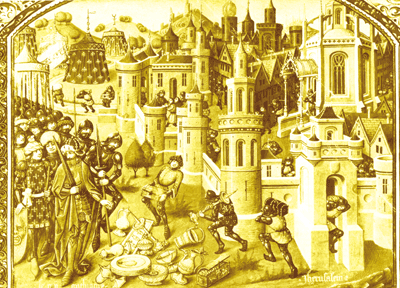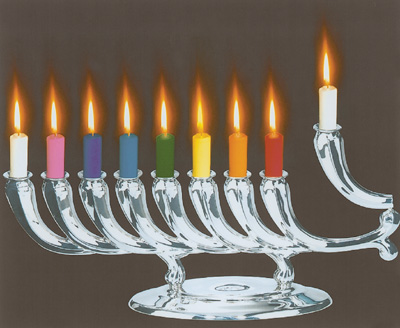THE JEWISH WORLD
The Camel and the
Hanukka Question
Hanukka has become one of
the most beloved and widely celebrated Jewish holidays. Yadin Roman
tells how this happened and why we celebrate Hanukka the way we do.

Despite the fact
that Hanukka is not a major holiday, it has become one of the most
symbolic Jewish festivals in Israel. In the late 1800s, the first Jewish
pioneers in the Land of Israel began to view it as a commemoration of
the regained independence of the Jewish people. The budding Zionist
movement found it easy to identify with the battle of the small band of
Maccabean freedom fighters against the might of the Seleucid
(Greek-Syrian) Empire, which resulted in the establishment of the Second
Jewish Commonwealth.
Pride in their
valiant predecessors led the early-twentieth-century founders of the
first Jewish sports club in the Land of Israel to name their
organization Maccabi. Young Maccabi was the name chosen for the Jewish
pioneer youth movement founded in Germany in 1926.
In the 1930s,
legendary tour guide Zev Vilnay began leading an annual Hanukka
excursion to a group of ancient graves near Lod that were thought at the
time to be the burial place of the Maccabees. The popular tour,
organized by the Histadrut (the Federation of Labor), gave rise to a
tradition among local youth movements to hike to the site during Hanukka.
The growing
association of the holiday with Jewish independence sparked other public
demonstrations of Hanukka pride, such as giant electric Hanukka menorahs
– hanukkiyot – sprouting on the roofs of synagogues in Israel and
America. Today during Hanukka, the hanukkiya glows atop the
Knesset and other public buildings throughout Israel.
Upstaged by a Jar of Oil
This glorification
of the Maccabees was not in keeping with the Jewish sages’ vision of the
festival. The sages were Pharisees, members of a movement that arose in
the second century BCE and insisted on the validity of its own oral
tradition. Most of the Maccabees were on the side of the Sadducees, who
were members of the traditional ruling class of priests and believed
only in the written law. After Jewish independence once again came to an
end, the sages made an effort to downplay the Maccabees’ role in the
festival by introducing a miraculous event: a jar of oil whose contents
lasted for eight days.

The Hanukka
tradition was first recorded in Maccabees, a collection of four
apocryphal books. The first two describe the revolt: 1 Maccabees is a
historical description and 2 Maccabees, written by Jason of Cyrene, is
aimed at demonstrating the steadfastness of the Jewish people against
their enemies over the ages.
The reconsecration
of the Temple in Jerusalem by Judah Maccabee and the establishment of a
festival to commemorate this occasion are described as follows in 1
Maccabees: “On the twenty-eighth day of the month of Kislev, in the year
148, they rose up in the morning and made sacrifices on the new altar.
And they consecrated the new altar on that day…and there was great
happiness among the people…and Judah and his brothers made it law unto
all the congregation of Israel to celebrate the consecration of the
Temple on the
twenty-fifth day of Kislev, for eight days year by year with joy and
thanksgiving to God.”
Why eight days?
According to 2 Maccabees, “They celebrated a festival to God for eight
days like the days of Sukkot, and they remembered the days before,
during which they had had to celebrate Sukkot in the mountains and
caves… and they took willow branches from the streams and palm leaves
and they sang a song of thanksgiving to God that had given them the
strength and forbearance to cleanse the Temple.”
And so, the two main
historical sources for the festival of Hanukka tell us that its purpose
is to commemorate hanukkat hamizbe’ah (consecration of the altar)
and the belated observance of the eight-day festival of Sukkot by the
Maccabees after they had regained control of the Temple.
The miraculous jar
of oil, which is not mentioned at all in the books of Maccabees, was
introduced much later by the talmudic sages. “What is Hanukka?” they ask
in tractate Shabbat of the Babylonian Talmud (21:3). “On the
twenty-fifth of Kislev, the days of Hanukka are eight…because when the
pagans entered the Temple they desecrated all the oils in the Temple.…”
When the Maccabees overcame them, they found one lone container of oil
still sealed with the seal of the high priest. Though there was only
enough oil to last for one day, “a miracle occurred and the oil gave
light for eight days.”
The generations that
followed celebrated the miracle of the little oil jar – and not the
victory of the Maccabees. However, the truth could not be entirely
hidden: a few centuries later, the prayer known as Al HaNissim (About
the Miracles) was added to the Hanukka and Purim liturgies. The version
recited during Hanukka recounts the story of the Maccabees’ rededication
of the Temple, with no mention of the oil jar. (The Purim version
relates to the miracle of the Jews’ deliverance from Haman.)
The Candle Debates
The subject of
Hanukka becomes even more complicated when we consider the Hanukka
ritual itself – the lighting of the candles.
The use of the term
“festival of lights” dates back to the writings of Josephus Flavius, a
first-century Jewish historian. Modern scholars have pointed out that
the festival falls near the shortest day of the year, December 21st,
when ancient cultures would light fires and torches in order to expel
the darkness. The Talmud echoes these fears when it relates that when
Adam saw the days becoming shorter, he was afraid he was about to die.
When the days grew longer, he celebrated for eight days.
The Talmud also
relates that the Maccabees could not use the candelabrum, or menorah, in
the Temple because it had been desecrated, and so they fashioned a
menorah from seven metal rods covered with wood. A later tradition
changed the number of rods from seven, the number of lights on the
original menorah, to eight.
The issue of how
many candles to light on Hanukka was discussed intensively by the sages
of the Talmud. Basically, they said that people should light one candle,
but if they were more observant they should light a candle for each
member of the family, while the most stringently observant should light
eight candles. The school of Shammai maintained that eight candles
should be lit on the first day, and then one candle less each subsequent
day, while the school of Hillel instructed that one candle should be lit
on the first day, and a candle added each subsequent day.
The sages also
discussed the source of the flame for the candles. They said that it is
forbidden to use Hanukka candles for any purpose other than to
commemorate the miracle of Hanukka. Accordingly, they reasoned, none of
the candles can be used to light the other candles or as a source of
light. They concluded that there has to be another source of light in
the house during the lighting of the candles, such as a hearth. In the
absence of another source of light, a ninth candle can serve that
purpose. In either case, that ninth candle can be used to light all of
the other candles. And so the extra candle, known as the shamash,
came into being and it is present in all hanukkiyot today.
Though the basic
structure remains the same, hanukkiyot take a variety of forms,
according to the creativity of their designers. Most of them contain
architectural elements from the place and time in which they were made.
The earliest metal hanukkiyot – made of bronze – date to the
fourteenth century.
Another question
that is discussed in the Talmud is where to put the hanukiyya
once it is lit. In general, it is said, the hanukkiya should be
placed outside the door of the house, so that it can be seen. If the
person lives on the upper floor of a house, he should place the
hanukiyya in a window. At times of danger, however, it is permissible to
put it on a table inside the house.
In a particularly
fascinating Talmudic debate relating to this subject, the following
question is asked: If a cargo of flax falls off a camel and lands in a
shop along the road, overturning a lamp lit by the proprietor and
causing a fire that burns down or damages the building, who pays for the
repairs? If the lamp was inside the building, it is proposed, the camel
owner pays; if the lamp had been placed outside the building, meaning in
the public area, the camel owner does not have to pay.
That is all well and
good, says Rabbi Yehuda, head of the Sanhedrin, but what if the lamp was
a hanukkiya, placed outside the door according to Jewish law?
Eventually, after much debate, Rabbi Yehuda’s reservations are rejected,
despite his high position. And so it is decided that even if it is a
hanukkiya that is overturned, the proprietor of the store will have
to pay for the repairs.
|

